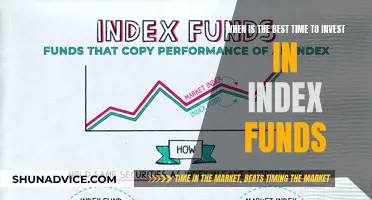
The Nasdaq-100 Index is a collection of the 100 largest, most actively traded non-financial companies listed on the Nasdaq Stock Exchange. It includes well-known technology companies such as Apple, Microsoft, and Amazon, but also has significant exposure to other sectors like consumer services, healthcare, and industrials. With its diverse range of sectors and impressive roster of innovative companies, the Nasdaq-100 Index is an attractive investment option for those seeking broad exposure to some of the world's largest companies. There are several ways to invest in the index, including exchange-traded funds (ETFs), mutual funds, futures, options, and annuities. When considering how to invest in the Nasdaq-100 Index, it is important to evaluate your financial goals, risk tolerance, and market outlook. Seeking advice from a financial advisor can help determine if this investment aligns with your financial circumstances.
| Characteristics | Values |
|---|---|
| Index name | Nasdaq-100 Index |
| Number of companies | 100 |
| Type of companies | Largest non-financial companies |
| Companies included | Microsoft, Apple, Amazon, Tesla, Meta, Cisco, Intel, Adobe, Netflix, NVIDIA, Gilead, Amgen, etc. |
| Index sectors | Consumer discretionary, telecommunications, consumer staples, basic materials, healthcare, industrials, technology, utilities |
| Investment options | ETFs, mutual funds, futures, options, annuities |
| Example ETFs | Invesco QQQ Trust, First Trust Nasdaq-100 Equal Weighted Index Fund, ProShares Ultra QQQ, ProShares UltraPro QQQ, etc. |
| Example mutual funds | Shelton NASDAQ-100 Index Direct |
| Example annuities | Annuities that track the Nasdaq-100 |
What You'll Learn

Exchange-traded funds (ETFs)
ETFs are bought and sold like common stock on a stock exchange. They are traded and experience price changes throughout the day. ETFs generally hold a collection of stocks, bonds, or other securities in one fund or have exposure to a single stock or bond through a single-security ETF.
ETFs are a good option for investors looking for an affordable, potentially tax-efficient way to access a broad range of asset classes. Here are some of the reasons ETFs work for many investors:
- ETFs let you access a diverse mix of asset classes, including domestic and international stocks, bonds, and commodities.
- ETFs typically have lower operating expense ratios (OERs) than actively managed mutual funds.
- ETFs combine the trading versatility of individual securities with the diversified qualities of mutual funds to meet a variety of investment needs.
- ETFs are widely considered more tax-efficient than actively managed mutual funds.
There are several types of ETFs, including:
- Index ETFs: Designed to track a particular index like the S&P 500 or NASDAQ.
- Fixed-Income ETFs: Designed to provide exposure to virtually every type of bond available; US Treasury, corporate, municipal, international, high-yield, and several more.
- Sector and Industry ETFs: Designed to provide exposure to a particular industry, such as oil, pharmaceuticals, or high technology.
- Commodity ETFs: Designed to track the price of a commodity, such as gold, oil, or corn.
- Style ETFs: Designed to track an investment style or market capitalization focus, such as large-cap value or small-cap growth.
- Foreign Market ETFs: Designed to track non-US markets, such as Japan's Nikkei Index or Hong Kong's Hang Seng index.
- Inverse ETFs: Designed to profit from a decline in the underlying market or index.
- Leveraged ETFs: Designed to use leverage to amplify returns.
- Actively Managed ETFs: Designed to outperform an index, unlike most ETFs, which are designed to track an index.
When investing in ETFs, it is important to consider the costs, such as broker commissions and operating expense ratios. Additionally, ETFs may have drawbacks, including trading costs, illiquidity, and tracking errors.
Betterment Investment Funds: Where is Your Money Located?
You may want to see also

Mutual funds
There are several mutual funds that track the Nasdaq-100 Index. Here are some of the most popular ones:
Shelton NASDAQ-100 Index Direct (NASDX)
This mutual fund began trading in 2000 and has a strong track record over the last five and ten years. The expense ratio for this fund is 0.52%, meaning that for every $10,000 invested, you will pay $52 annually. This fund is suitable for investors looking for exposure to the tech industry and growth-oriented companies.
USAA Nasdaq-100 Index Fund (USNQX)
The USAA Nasdaq-100 Index Fund is offered by Victory Capital Management and has been around since October 2000. It has a small fraction of the assets of some other funds, but it has delivered strong performance, ranking in the top 10% of funds in its category over the long term. The expense ratio for this fund is 0.45%, which is higher than the average for ETFs but still relatively low compared to other funds.
Invesco Nasdaq 100 Index Fund (IVNQX)
This fund was launched by Invesco in October 2020 and allows investors to track the Nasdaq-100 Index in mutual fund form. It is designed to reach a broader audience, specifically retirement accounts that typically cannot access ETFs. This fund is only available to certain institutional investors and requires a minimum investment of $1 million.
Invesco ESG Nasdaq 100 ETF (QQMG)
The Invesco ESG Nasdaq 100 ETF invests in Nasdaq-100 stocks that meet specific environmental, social, and governance (ESG) criteria. This fund was launched in October 2021 to meet the growing demand for ESG investments. The expense ratio for this fund is not available, but it is important to note that ESG funds may have higher fees due to the additional screening and research involved.
Direxion Nasdaq-100 Equal Weighted Index Shares (QQQE)
This fund offered by Direxion invests in an equal-weighted version of the Nasdaq-100 Index. The index is rebalanced quarterly, resetting each of the 100 stocks to 1% of assets. This reduces the risk associated with single-stock exposure, as each stock has the same weight regardless of its performance. However, it also means that the fund may not fully capture the upside of the strongest-performing stocks.
When investing in mutual funds, it is important to consider factors such as expenses, taxes, investment minimums, long-run performance, expense ratios, trading costs, and fund options. Mutual funds may charge sales loads (commissions) and expense ratios (ongoing fees based on assets). Be sure to compare the fees and performance of similar funds before making a decision.
Trust Fund Investment: Strategies for Long-Term Wealth
You may want to see also

Futures and options
Futures
The Nasdaq-100 Index (NDX) is a modified capitalisation-weighted index of the 100 largest and most active non-financial domestic and international companies listed on the NASDAQ. The index is made up of companies from a variety of sectors, including technology, healthcare, and consumer staples.
Nasdaq-100 futures can be a great hedge against swings in tech earnings as they offer multiple kinds of protection. They are a riskier derivative best suited for more sophisticated investors. The contracts provide a way to invest in commodities markets and are often used for hedging or speculation. They have higher liquidity than options.
Options
Options are also riskier contracts best suited for sophisticated investors. They provide investors with the option to buy or sell a security at a specific date and price. Options can be a dependable form of hedging and are less liquid than futures.
Nasdaq-100 Index Options (NDX) offer investors the opportunity to capitalise on the performance of innovative companies in the index. They can be used to protect a portfolio against a market correction, hedge risks, or generate yield enhancement. Think of options as buying an insurance policy with a one-time premium payment.
There are various types of Nasdaq-100 options:
- NDX: Nasdaq's flagship index options product. The underlying value is equal to the full value of the Nasdaq-100 Index (NDX).
- NQX: Reduced value index options product. NQX is based on 1/5th (20%) the full value of the Nasdaq-100 index, offering investors lower notional exposure while tracking the Nasdaq-100.
- XND: Nasdaq 100 micro index options product. XND is based on 1/100th (1%) the full value of the Nasdaq-100 index. The smaller notional value of the micro contract is designed to provide investors with a more precise and manageable way to hedge or gain exposure to the Nasdaq-100 index.
Exchange-Traded Funds (ETFs)
The exchange-traded fund route is one of the easiest ways to gain exposure to the NDX. ETFs offer the benefits of a diversified portfolio and typically track a pool of assets, such as an index, sector, or commodity. They can be easily traded like stocks.
Examples of ETFs that track the Nasdaq-100 include:
- Invesco QQQ Trust, Series 1 ETF (QQQ)
- First Trust Nasdaq-100 Equal Weighted Index Fund (QQEW)
- ProShares Ultra QQQ (QLD)
- ProShares UltraPro QQQ (TQQQ)
- ProShares UltraPro Short QQQ (SQQQ)
- ProShares Short QQQ (PSQ)
- ProShares UltraShort QQQ (QID)
A Guide to Mutual Funds and Share Investing
You may want to see also

Annuities
If you are investing in a long-term retirement vehicle or life insurance, annuities that track the Nasdaq-100® are worth considering. These annuities have consistently performed well over time and are a great barometer of the economy.
However, it is important to remember that annuities have low growth compared to other investments. Before investing, it is recommended that you consult a securities professional for advice.
Investing in Funds: Smart Money Management for Long-Term Growth
You may want to see also

Long-term investment goals
When considering long-term investment goals, it is important to remember that the Nasdaq-100 is a large-cap growth index with a proven history of high index performance. It is well-suited for long-term savings and building wealth. Here are some key points to consider:
- The Nasdaq-100 includes 100 of the largest domestic and international non-financial companies listed on the Nasdaq Stock Market based on market capitalization. It is dominated by well-known technology companies such as Apple, Amazon, Microsoft, and Alphabet, giving it an impression as a technology index. However, other sectors such as consumer services, healthcare, consumer goods, and industrials constitute the remaining 50%.
- The Nasdaq-100 has generated higher growth rates than competing indexes such as the S&P 500 Index and the Russell 1000 Growth Index since 2008. This makes it an attractive option for investors seeking long-term growth.
- There are multiple ways to invest in the Nasdaq-100, including exchange-traded funds (ETFs), mutual funds, options, futures, and annuities. ETFs are a popular choice due to their diversification benefits and ease of trading like stocks.
- When investing for the long term, it is essential to consider the fund's expenses, such as the expense ratio, trading costs, and investment minimums. Lower expense ratios and trading costs can result in higher returns over time.
- Long-run performance should also be considered when selecting an index fund. While past performance does not guarantee future results, it can provide an indication of potential future returns.
- For long-term investment goals, passive investing is often recommended. This involves a "buy-and-hold" strategy, typically investing in index funds for the long term.
- Mutual funds are also an option for long-term investors seeking minimal risk and diversified exposure. Annuities, which provide guaranteed income after retirement, are another choice for those investing in a long-term retirement vehicle.
- When investing in the Nasdaq-100 for the long term, it is important to remember that it is a tech-heavy index. While it has outperformed the S&P 500 in terms of returns, it may be more volatile due to its concentration in the technology sector. Therefore, it may be more suitable for investors with a higher risk tolerance.
T. Rowe Price Funds: Cruise Investment Options Explored
You may want to see also
Frequently asked questions
The Nasdaq 100 Index is a collection of the 100 largest, most actively traded companies listed on the Nasdaq stock exchange. The index includes companies from diverse industries like manufacturing, technology, healthcare, and others. The index excludes those in the financial sector, like commercial and investment banks.
There are multiple ways to invest in the Nasdaq 100 Index, such as exchange-traded funds (ETFs), mutual funds, options, futures, and annuities. For the average investor, ETFs are generally the simplest and least risky means of gaining exposure to the companies in the index.
Examples of ETFs that track the Nasdaq 100 Index include the Invesco QQQ Trust, First Trust Nasdaq-100 Equal Weighted Index Fund, and Fidelity Nasdaq Composite Index ETF.







